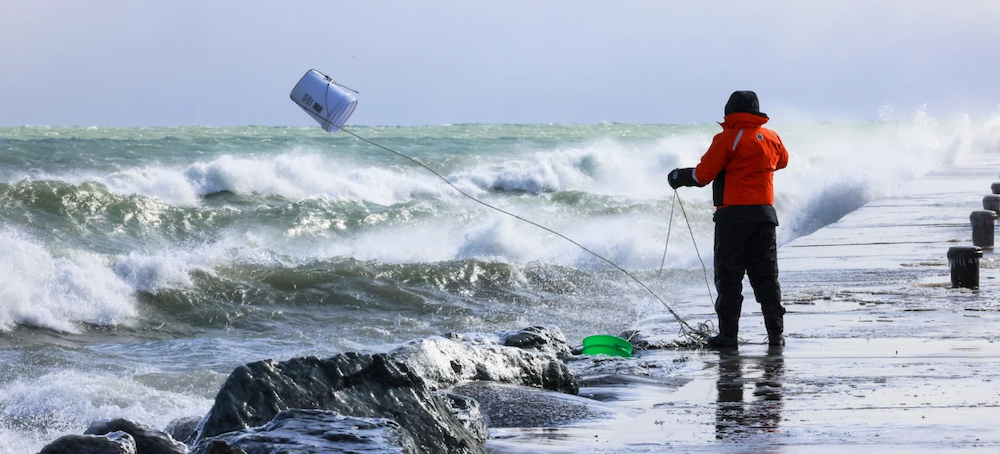A Lack of Ice Is Reshaping Winter Life Around the Great Lakes
Evan Bush NBC News Rae-Ann Eifert, a lake monitor for the Wisconsin Department of Natural Resources, gathers buckets of water for testing off a Lake Michigan breakwater in Racine on Feb. 28 as part of an effort across the Great Lakes to understand the effects of an iceless winter. (photo: Teresa Crawford/AP)
Rae-Ann Eifert, a lake monitor for the Wisconsin Department of Natural Resources, gathers buckets of water for testing off a Lake Michigan breakwater in Racine on Feb. 28 as part of an effort across the Great Lakes to understand the effects of an iceless winter. (photo: Teresa Crawford/AP)
The lack of snow and lake ice has left some hearty Midwesterners who ski, skate and fish to question how their lifestyles will persist as the world warms.
Average ice cover is hovering at all-time lows for this time of year. Snowfall continues to lag well behind its usual marks. And long-range forecasts are calling for more unseasonable heat.
Just 5.6% of the Great Lakes was covered in ice from January to early March, according to James Kessler, a physical scientist with the Great Lakes Environmental Research Laboratory, a part of the National Oceanic and Atmospheric Administration.
“We are trending toward breaking a record” for the least yearly ice cover, on average, in about 50 years, Kessler said. “It’s been a very warm winter.”
The lack of ice cover — which Kessler said was most likely linked to climate change, El Niño and natural variability — could offer a glimpse of the region’s future as the world warms. The lack of snow and lake ice has left some hearty Midwesterners who ski, skate and fish to question how their lifestyles will persist.
“I’m not skiing. It sucks,” said M Baxley, an outdoors guide and podcaster who owns a media company. “The psychological impact, through the change of recreation for many people and the fear of what will the future look like, is an element.”
Ice on the Great Lakes varies significantly from year to year and during the season, typically peaking in late February or early March. In 2019, the last big ice year, the maximum amount of seasonal ice covered about 81% of the surface of the Great Lakes, Kessler said.
This season, hardly any formed.
Apart from a two-week stretch of cold weather in January, there simply weren’t enough days with consistent below-freezing temperatures to form ice on the lakes’ surfaces.
The amount of ice on the Great Lakes — Superior, Michigan, Huron, Erie and Ontario — affects shipping to ports in the Midwest and the Rust Belt.
Lower ice levels affect the reproduction of some species of fish and increase erosion on lakeshores, and they could shift patterns in weather, such as how much lake-effect snow falls on nearby communities.
Kessler’s research shows the annual maximum for ice coverage has trended lower, at a rate of about 5%, each decade from 1973 to 2023.
Poor ice conditions have forced ice fishers toward inland bodies of water.
“In the Duluth area, their season has been nonexistent and definitely impacted their ability to get on the ice in Lake Superior,” said Joe Friedrichs, who operates the “Paddle and Portage” podcast with Baxley about the Boundary Waters in northern Minnesota.
Ice fishers have turned instead to inland lakes, which are small enough to have frozen over in relatively mild temperatures and are easy to get to because there’s little snow on the ground.
As of Thursday, just 3.4% of the northern Great Lakes region was covered in snow, according to satellite analysis from the National Operational Hydrologic Remote Sensing Center.
Only 19 inches of snow had fallen in Duluth, Minnesota, on Lake Superior, from October through February, according to the National Weather Service; it averaged about 68 inches of snowfall every year over that period from 1991 to 2020. Cleveland, on Lake Erie, had received 20 inches through February; it averaged about 50 during that period. Chicago, on Lake Michigan, received 21 inches of snow; it averages 31.
Snowshoes haven’t been needed much this season, Friedrichs said.
“It’s bare ice and earth across the Boundary Waters,” Friedrichs said, referring to a wilderness area in northern Minnesota. “It kind of sucks. I live up here because I love the winter. I like the cold and the snow and the challenge of it.”
The lack of snowfall has been a challenge for some who depend on it for business.
“People have not been coming up to go skiing or snowshoeing or snowmobiling,” said John Silliman, of Stone Harbor Wilderness Supply, in Grand Marais, Minnesota, a winter tourism hot spot on the shores of Lake Superior. “The economy is definitely getting hit in this county.”
Temperatures have trended well above normal throughout the region. Minnesota, Wisconsin and Michigan have had their “warmest meteorological winter on record,” according to AccuWeather meteorologists.
The trend is expected to continue into spring. Long-term outlooks from the National Climate Prediction Center suggest the Great Lakes region can expect above-normal temperatures well into the spring months.
Wildfires will be a concern in the Great Lakes region over the next several months without snow on the landscape and with hot weather predicted.
The National Interagency Fire Center said wildfire risk will be elevated in March and April throughout much of the Upper Midwest, including Minnesota, Wisconsin and parts of Michigan.



